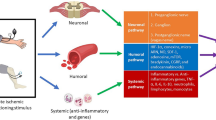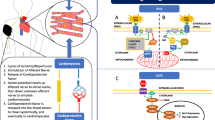Abstract
The protection conferred by ischemic preconditioning (PC) of myocardium occurs in a bimodal time course. The early cardioprotection wanes rapidly and is succeeded by a delayed phase of protection. This “second window” lasts for up to 72 hours, depending on species and end-point. A widely adopted paradigm for delayed PC is the following: 1) freely diffusible molecules or radicals, generated during the PC period, act in autocrine and/or paracrine manner as triggers of cellular adaptation; 2) they cause the activation of a protein kinase signal cascade; 3) the activated kinases phosphorylate important substrate proteins. In the case of delayed PC, it is thought that the phosphorylation of transcription factors, initiating the synthesis of late appearing effector proteins that promote cell survival during subsequent ischemia, may be a crucial event. Investigation of the proximal components of this sequence has altered our perceptions of several biological mediators, previously thought to be short acting, including adenosine, NO, free radicals and bradykinin. Signal transduction components include protein kinase C, tyrosine kinases and various mitogen- and stress-activated protein kinases but their patterns of regulation are complex and as yet poorly defined. Gene expression is modified in a regulated fashion to induce new proteins that promote cell repair and to protect against subsequent ischemia-reperfusion insult. It is likely that the complex nature of the preconditioning stimulus causes the activation of a variety of transcription factors, regulating a large number of target genes. So far, attention has focussed on a small number of protein products as potential distal mediators of delayed preconditioning. These include the heat shock proteins, manganese superoxide dismutase, inducible nitric oxide synthase, the ATP-sensitive potassium channel and cyclo-oxygenase-2.
Similar content being viewed by others
Author information
Authors and Affiliations
Additional information
Received: 20 November 2000 / Returned for revision: 7 December 2000 / Revision received: 27 February 2001 / Accepted: 12 March 2001
Rights and permissions
About this article
Cite this article
Baxter, G., Ferdinandy, P. Delayed preconditioning of myocardium: current perspectives. Basic Res Cardiol 96, 329–344 (2001). https://doi.org/10.1007/s003950170041
Issue Date:
DOI: https://doi.org/10.1007/s003950170041




